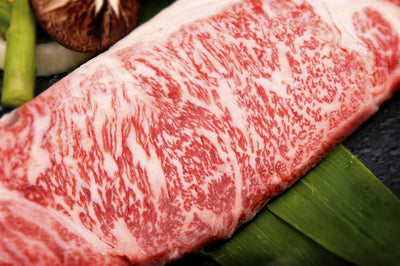What's the fuss about Marbling?
Marbling simply refers to the fat found within a cut of meat and between the muscle fibers themselves. A high-quality steak will have a lot of marbling, while a lean cut will have very little or no visible marbling. The fat should be pure white and hard, and the best is when it's distributed evenly throughout the entire cut of meat.
Steaks and other cuts of meat with a lot of marbling mostly come from the loin region of the animal. This is on the back of the animal where the muscles get very little exercise in comparison to the legs, shoulders, and rump. Excess calories from the cow's diet get stored here in the form of fat.
As the meat cooks, the fat melts. The melted fat does two things: it keeps the meat tender and moist, and it infuses the meat with flavor. In fact, most of the silky texture and great beef flavor that we love in a steak comes from the fat, not the meat itself!
Without this marbling, the cut would end up as dry and flavorless as cardboard. Even with a well-marbled cut of meat, you can still end up with cardboard if you overcook it! Cooked too long and all the fat renders out, leaving the steak bone-dry and completely tasteless.
The best way to cook steak is to sear it quickly over high heat and then cook it in a hot oven until it has reached the desired doneness. We really like Chris's method of cooking the steak in a hot cast-iron pan under the broiler.
If you're trying to watch your figure and are concerned about the fat content of a well-marbled cut of beef, we recommend moderation. Eat steak less often or in smaller portions, but stick with the marbled steaks.
What's your favorite cut of steak?
Information sourced from Emma Christensen of The Kitchn.


















Leave a comment